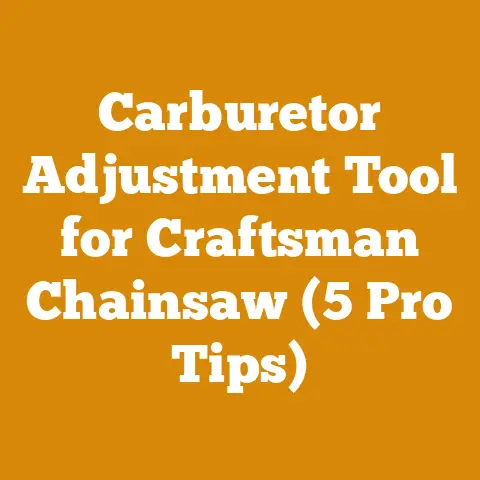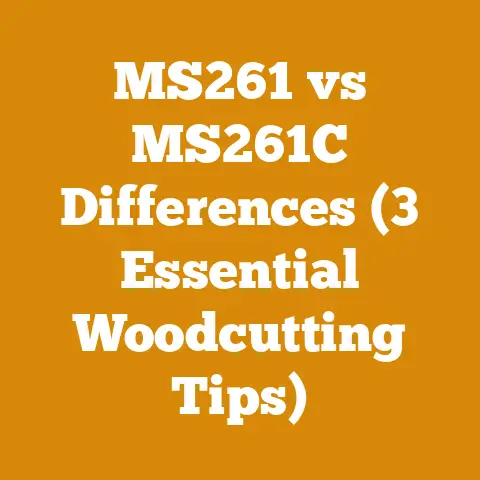Stihl Chainsaw Air Filter Replacement Guide (Pro Tips for MS362 & 400)
As someone who’s spent a significant portion of my life around chainsaws, wood, and the satisfying crackle of a well-built fire, I understand the importance of maintaining your equipment. A chainsaw is more than just a tool; it’s an extension of your skill and a vital part of your livelihood or hobby. And just like any finely tuned machine, it requires regular care. That’s why I’m dedicating this guide to the often-overlooked but crucial task of air filter replacement, specifically focusing on the Stihl MS362 and MS400 chainsaws.
Think of it this way: you wouldn’t run a marathon without proper training and nutrition, would you? Similarly, you shouldn’t expect your chainsaw to perform optimally with a clogged air filter. It’s like trying to breathe through a thick wool sock – the engine will struggle, performance will suffer, and you risk causing long-term damage.
This guide isn’t just about replacing an air filter; it’s about future-proofing your investment. A well-maintained chainsaw will last longer, perform better, and save you money in the long run. I’ve seen firsthand the consequences of neglecting simple maintenance tasks, and I’m here to help you avoid those pitfalls.
Stihl Chainsaw Air Filter Replacement Guide: Pro Tips for MS362 & MS400
Introduction: Why Air Filter Maintenance Matters
The air filter is the unsung hero of your chainsaw. It’s the first line of defense against dust, debris, and sawdust that can wreak havoc on your engine. A clean air filter ensures proper airflow, which is essential for:
- Optimal Engine Performance: A clean filter allows the engine to breathe easily, resulting in maximum power and efficiency.
- Fuel Efficiency: A restricted air filter forces the engine to work harder, consuming more fuel.
- Engine Longevity: Dust and debris entering the engine can cause wear and tear on critical components, shortening its lifespan.
- Reduced Downtime: Regular maintenance, including air filter replacement, minimizes the risk of breakdowns and costly repairs.
I remember one instance where a fellow firewood processor was constantly complaining about his MS362 losing power. He was ready to trade it in for a new model. After a quick inspection, I discovered his air filter was completely caked with sawdust. After replacing it, his chainsaw ran like new. He was amazed at the difference such a small part could make.
Understanding Key Concepts
Before we dive into the step-by-step guide, let’s define some key terms:
- Air Filter: A component designed to trap dust, debris, and other particles from entering the engine.
- Air Filter Cover: The housing that protects the air filter.
- Pre-Filter (optional): A coarse filter that sits in front of the main air filter, providing an extra layer of protection.
- Carburetor: The part of the engine that mixes air and fuel. A dirty air filter can negatively affect the carburetor’s performance.
- RPM (Revolutions Per Minute): A measure of how fast the engine is running. A clean air filter helps maintain optimal RPM.
- Green Wood vs. Seasoned Wood: Green wood is freshly cut and has a high moisture content, while seasoned wood has been dried and has a lower moisture content. Cutting green wood often produces more sawdust, which can quickly clog the air filter.
Tools and Materials You’ll Need
- New Air Filter: Make sure to get the correct air filter for your Stihl MS362 or MS400. Using the wrong filter can damage your chainsaw.
- Screwdriver (usually flathead or Torx): The type of screwdriver needed will depend on the screws securing the air filter cover.
- Brush or Compressed Air: For cleaning the air filter compartment and the pre-filter (if applicable).
- Clean Rags: For wiping down surfaces.
- Work Gloves: To protect your hands.
- Optional: Carburetor Cleaner: If you suspect the carburetor is affected by a dirty air filter, you may want to use carburetor cleaner.
Step-by-Step Air Filter Replacement Guide for Stihl MS362 & MS400
The process for replacing the air filter on the Stihl MS362 and MS400 is very similar, with minor variations. I’ll highlight any specific differences along the way.
Step 1: Safety First
- Turn off the chainsaw: Ensure the chainsaw is switched off and the chain brake is engaged.
- Remove the spark plug wire: Disconnecting the spark plug wire prevents accidental starting. This is a crucial safety precaution.
- Let the engine cool: If the engine has been running, allow it to cool down before proceeding.
Step 2: Locate and Remove the Air Filter Cover
- Identify the air filter cover: The air filter cover is typically located on top or on the side of the chainsaw, near the carburetor.
- Loosen the screws: Use the appropriate screwdriver to loosen the screws securing the air filter cover. Some models may have quick-release levers instead of screws.
- Remove the cover: Carefully remove the air filter cover. Note the orientation of the cover and any components inside for reassembly.
Step 3: Inspect the Air Filter and Pre-Filter (if applicable)
- Examine the air filter: Carefully remove the air filter from its compartment. Inspect it for dirt, debris, and damage. If the filter is heavily soiled, it’s time for a replacement.
- Check the pre-filter: Some models, particularly those used in dusty conditions, have a pre-filter. Remove the pre-filter and inspect it. Clean it with a brush or compressed air if it’s dirty. If it’s damaged, replace it.
Step 4: Clean the Air Filter Compartment
- Remove debris: Use a brush or compressed air to remove any dirt, sawdust, or debris from the air filter compartment.
- Wipe down surfaces: Use a clean rag to wipe down the surfaces of the compartment.
Step 5: Install the New Air Filter
- Orient the new filter: Ensure the new air filter is correctly oriented before installing it. Most filters have a specific direction they need to be installed in.
- Insert the filter: Carefully insert the new air filter into its compartment. Make sure it sits flush and is properly seated.
Step 6: Reinstall the Pre-Filter (if applicable)
- Place the pre-filter: If your chainsaw has a pre-filter, reinstall it over the main air filter.
- Ensure proper fit: Make sure the pre-filter is properly seated and covers the main air filter completely.
Step 7: Reinstall the Air Filter Cover
- Position the cover: Align the air filter cover with its mounting points.
- Secure the screws or levers: Tighten the screws or engage the quick-release levers to secure the air filter cover. Make sure the cover is properly sealed to prevent air leaks.
Step 8: Reconnect the Spark Plug Wire
- Attach the wire: Reconnect the spark plug wire to the spark plug.
- Ensure a secure connection: Make sure the connection is secure to prevent misfires.
Step 9: Test the Chainsaw
- Start the engine: Start the chainsaw and let it idle for a few minutes.
- Check for smooth operation: Listen for any unusual noises or vibrations. The engine should run smoothly and respond well to throttle adjustments.
Specific Notes for MS362 and MS400:
- MS362: The MS362 typically uses a standard paper or felt air filter. Some models may have a pre-filter, especially those used in dusty environments.
- MS400: The MS400 often features a heavy-duty air filter system, sometimes with a multi-stage filtration process. Pay close attention to the orientation of the filter elements when replacing them. The MS400 filter is also larger and more robust.
Pro Tips for Air Filter Maintenance
- Regular Inspection: Check your air filter regularly, especially if you’re cutting in dusty or dirty conditions. I usually check mine after every tank of fuel.
- Cleaning vs. Replacement: While some air filters can be cleaned with compressed air, it’s generally recommended to replace them when they become heavily soiled or damaged. Cleaning is a temporary fix.
- Use Genuine Stihl Parts: Using genuine Stihl air filters ensures proper fit and performance. Aftermarket filters may not meet the same quality standards.
- Consider a Pre-Filter: If you frequently cut in dusty conditions, consider using a pre-filter to extend the life of your main air filter.
- Proper Storage: Store your chainsaw in a clean and dry place to prevent dirt and debris from entering the air filter compartment.
- Carburetor Adjustment: If you notice a significant change in engine performance after replacing the air filter, you may need to adjust the carburetor. Consult your owner’s manual or a qualified technician for assistance.
Case Study: Reviving a Neglected MS362
I once worked with a small logging crew that had an MS362 that was consistently underperforming. The saw was hard to start, lacked power, and consumed excessive fuel. The crew was convinced the saw was nearing the end of its life.
Upon inspection, I found that the air filter was completely clogged with a mixture of sawdust, dirt, and oil. It was so bad that it was restricting airflow to the engine. The carburetor was also likely affected.
I replaced the air filter with a new genuine Stihl filter and cleaned the air filter compartment. I also recommended they have the carburetor professionally cleaned and adjusted.
The result was remarkable. The MS362 started easily, had significantly more power, and consumed less fuel. The crew was amazed at the difference a simple air filter replacement could make. This experience highlighted the importance of regular air filter maintenance and how it can significantly impact chainsaw performance and longevity.
Strategic Advantages of Proper Air Filter Maintenance
Beyond the immediate benefits of improved performance and fuel efficiency, proper air filter maintenance offers several strategic advantages:
- Reduced Repair Costs: By preventing engine damage, regular air filter maintenance can save you money on costly repairs in the long run.
- Increased Productivity: A well-maintained chainsaw operates more efficiently, allowing you to complete tasks faster and with less effort.
- Extended Chainsaw Lifespan: Regular maintenance, including air filter replacement, can significantly extend the lifespan of your chainsaw, protecting your investment.
- Improved Safety: A properly functioning chainsaw is safer to operate. A clogged air filter can cause the engine to stall or misfire, increasing the risk of accidents.
- Higher Resale Value: A well-maintained chainsaw will have a higher resale value if you ever decide to upgrade.
Technical Details and Specifications
- Air Filter Material: Stihl air filters are typically made of paper, felt, or foam. Some models use a combination of materials.
- Filter Pore Size: The pore size of the air filter is critical for trapping fine particles while allowing adequate airflow. Stihl air filters are designed to meet specific pore size requirements for optimal performance.
- Airflow Rate: A clean air filter should allow for a specific airflow rate, measured in cubic feet per minute (CFM). A clogged air filter will significantly reduce the airflow rate.
- Replacement Frequency: The recommended replacement frequency for air filters varies depending on the operating conditions. In general, it’s recommended to replace the air filter every 25 to 50 hours of use, or more frequently if you’re cutting in dusty conditions.
- Cost of Air Filter: The cost of a genuine Stihl air filter for the MS362 or MS400 typically ranges from $10 to $20.
Drying Methods and Moisture Content Targets
While seemingly unrelated, understanding wood drying and moisture content is crucial for minimizing sawdust and debris that can clog your air filter.
- Air Drying: This is the most common method for drying firewood. Stack the wood in a well-ventilated area, off the ground, and cover the top to protect it from rain. Aim for a moisture content of 20% or less.
- Kiln Drying: This method uses controlled heat and humidity to dry wood quickly. Kiln-dried wood typically has a moisture content of 6-8%.
- Moisture Content Targets: For firewood, aim for a moisture content of 20% or less. This will ensure that the wood burns efficiently and produces less smoke. For woodworking projects, the target moisture content will vary depending on the species of wood and the intended use.
Cutting green wood produces significantly more sawdust, which quickly clogs air filters. Seasoned wood produces less sawdust, reducing the frequency of air filter maintenance.
Chainsaw, Axes, and Log Splitter Specifications
To maximize efficiency and minimize debris, consider the following tool specifications:
- Chainsaw Chain Type: A sharp chain produces cleaner cuts and less sawdust. Choose a chain type that is appropriate for the type of wood you are cutting.
- Axe Weight and Length: Choose an axe that is appropriate for your strength and experience. A heavier axe is more efficient for splitting large logs, but it can also be more tiring to use.
- Log Splitter Tonnage: Choose a log splitter with sufficient tonnage for the size and type of wood you are splitting. A hydraulic log splitter is more efficient than a manual log splitter.
Firewood Stacking Techniques
Proper firewood stacking not only helps with drying but also minimizes the amount of dirt and debris that can accumulate on the wood, reducing the amount of dust that can clog your air filter.
- Stacking off the Ground: Use pallets or other materials to keep the firewood off the ground.
- Cross-Stacking: Cross-stacking the wood at the ends of the stack helps to improve airflow and prevent the stack from collapsing.
- Covering the Top: Cover the top of the stack with a tarp or other waterproof material to protect it from rain.
Practical Next Steps
Now that you understand the importance of air filter maintenance and how to replace the air filter on your Stihl MS362 or MS400, here are some practical next steps:
- Inspect your air filter: Take a few minutes to inspect the air filter on your chainsaw. If it’s dirty or damaged, replace it.
- Purchase a new air filter: Order a genuine Stihl air filter for your MS362 or MS400.
- Clean your air filter compartment: Clean the air filter compartment to remove any dirt or debris.
- Develop a maintenance schedule: Create a regular maintenance schedule for your chainsaw, including air filter replacement, chain sharpening, and lubrication.
- Share this guide: Share this guide with other chainsaw users to help them maintain their equipment and improve their performance.
Conclusion
Maintaining your chainsaw’s air filter is a small task that yields significant rewards. By following the steps outlined in this guide and implementing the pro tips, you can ensure your Stihl MS362 or MS400 runs smoothly, efficiently, and reliably for years to come. Remember, a well-maintained chainsaw is a safe and productive chainsaw. So, take the time to care for your equipment, and it will take care of you.






